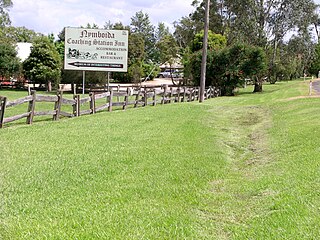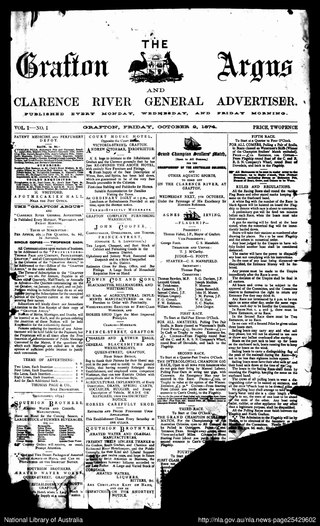Related Research Articles

Grafton is a city in the Northern Rivers region of the Australian state of New South Wales. It is located on the Clarence River, on a floodplain, approximately 608 kilometres (378 mi) by road north-northeast of the state capital Sydney.

Summerland Way is a 199–kilometre state route, designated B91, in New South Wales. It runs generally north from Grafton to the state border with Queensland just west of Mount Lindesay, and continues from there into Queensland as Mount Lindesay Highway. It was named as the region in runs through is a popular tourist area for people during summer.
A no-liability company in Australia is a company which, under the Corporations Act 2001 (Cth), must have as its stated objects that it is solely a mining company and that it is not entitled to calls on the unpaid issue price of shares. It is a company which is restricted to mining activities and is the only sort of corporation which is entitled to this form of liability, given the sometimes financially risky business of mining. Most of the usual rules in the Act apply to no-liability companies, save that a mining company must adopt a constitution which states their objects as mining.
The Limelight Department was one of the world's first film studios, beginning in 1898, operated by The Salvation Army in Melbourne, Australia. The Limelight Department produced evangelistic material for use by the Salvation Army, including lantern slides as early as 1891, as well as private and government contracts. In its 19 years of operation, the Limelight Department produced about 300 films of various lengths, making it one of largest film producers of its time.

Albert Clayton Palmer was an Australian politician. He was a member of the Australian House of Representatives from 1906 to 1907 and from 1907 until his death, representing the electorate of Echuca for the Anti-Socialist Party and its successors the Commonwealth Liberal Party and Nationalist Party.

Allan McDougall was an Australian politician. He was a Labor member of the Australian Senate from 1910 to 1919 and from 1922 until his death in 1924.
The Industrial Socialist Labor Party, Industrial Labor Party and the Independent Labor Party were short lived socialist political parties in Australia in 1919 and the early 1920s. The Industrial Socialist Labor Party was founded by radical socialist members of the industrial wing of the Australian Labor Party (ALP), at a time when the ALP's socialist ideology was a matter of intra-party dispute. It was closely aligned with the Industrial Workers of the World (IWW) and the One Big Union (OBE) movement.
The Daily Examiner is a daily newspaper serving Grafton, New South Wales, Australia. The newspaper is owned by News Corp Australia. At various times the newspaper was known as The Clarence and Richmond Examiner and New England Advertiser (1859–1889) and Clarence and Richmond Examiner (1889–1915).

Michael Rush was an Irish Australian sculler noted for his one-on-one competitions against champion opponents, which drew vast crowds of spectators. He attempted to win the World Sculling Championship.

Nymboida is a rural village in the Northern Rivers region of New South Wales, Australia. It is about 21 kilometres south-west of Coutts Crossing, 44 kilometres south-west of Grafton and approximately 687 km north of Sydney. Nymboida is close to the challenging and popular white water rafting waters of the Nymboida River along the Armidale–Grafton Road. The village is in the Clarence Valley Council local government area.
Clarence, an electoral district of the Legislative Assembly in the Australian state of New South Wales, has had two incarnations, the first from 1859 to 1920, the second from 1927 to the present.
Thomas Frederic De Courcy Browne was an Irish-born Australian politician and journalist.
The Border Police of New South Wales was a frontier policing body introduced by the colonial government of New South Wales with the passing of the Crown Lands Unauthorised Occupation Act 1839.

The Grafton Argus and Clarence River General Advertiser, published under a variety of mastheads over the years, was published three times per week in the beginning. It then became a twice weekly publication but then in late 1920 or the beginning of 1921 it was published daily except Sundays. It was published in Grafton, on the far north coast of New South Wales, Australia, situated on the Clarence River.

The Socialist Labor Party was a socialist political party of Australia that existed from 1901 to the 1970s. Originally formed as the Australian Socialist League in 1887, it had members such as George Black, New South Wales Premier William Holman and Prime Minister Billy Hughes.
Dr. Robert Dalley-Scarlett was an Australian organist, choirmaster, composer and musicologist.
Copmanhurst Shire was a local government area in the Northern Rivers region of New South Wales, Australia.

The Wanganui was an iron Brigantine Twin Boiler Screw steamer built by Gourlay Brothers & Co and launched in July 1863 for the Wanganui Steam Navigation Company for trade around the Wanganui region of New Zealand. The vessel served in this region up to 1873 when its ownership was transferred to Messrs Henry Houghton and Co., of Dunedin. In 1880 the vessel was transferred in to the Australian East coast service where it sank whilst entering Clarence River on 20 June 1880.
Dalmorton is a locality in the Northern Rivers region of New South Wales, Australia. There once was a village of the same name, which was associated with gold mining. Much of the area of the locality is now reserved as National Parks or State Forests. At the 2016 census, the population of Dalmorton was four.

Sir Clarence Roy McKerihan, also known as Roy McKerihan or C. R. McKerihan, was an Australian banker who served as a commissioner and President of the Rural Bank of New South Wales for 27 years from 1933 to 1961.
References
- 1 2 ""CHRIST AMONG MEN."". The Grafton Argus And Clarence River General Advertiser . New South Wales, Australia. 24 September 1906. p. 2. Retrieved 8 October 2020– via National Library of Australia.
- 1 2 "Biorama Company". The Richmond River Express And Casino Kyogle Advertiser . New South Wales, Australia. 28 September 1906. p. 4. Retrieved 8 October 2020– via National Library of Australia.
- ↑ "THE SALVATION ARMY BIORAMA". Goulburn Evening Penny Post . New South Wales, Australia. 20 August 1907. p. 4. Retrieved 8 October 2020– via National Library of Australia.
- ↑ "THE BIORAMA COMPANY". The Grafton Argus And Clarence River General Advertiser . New South Wales, Australia. 20 September 1906. p. 4. Retrieved 8 October 2020– via National Library of Australia.